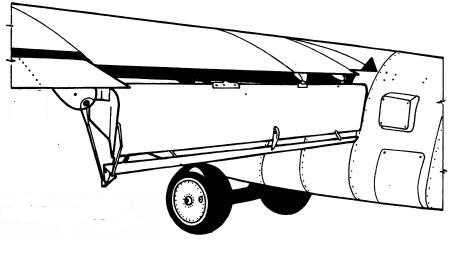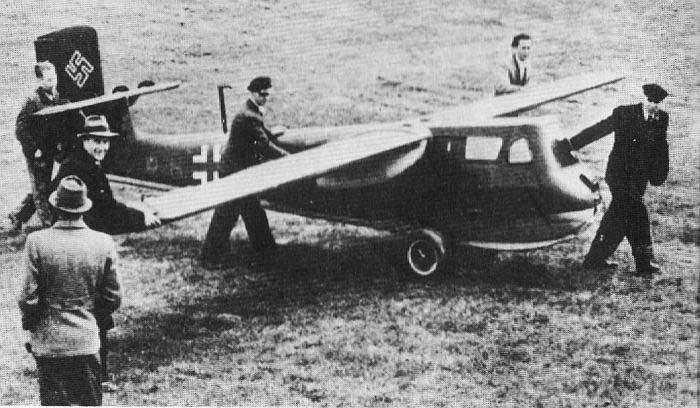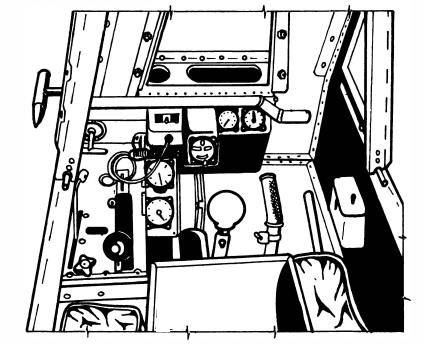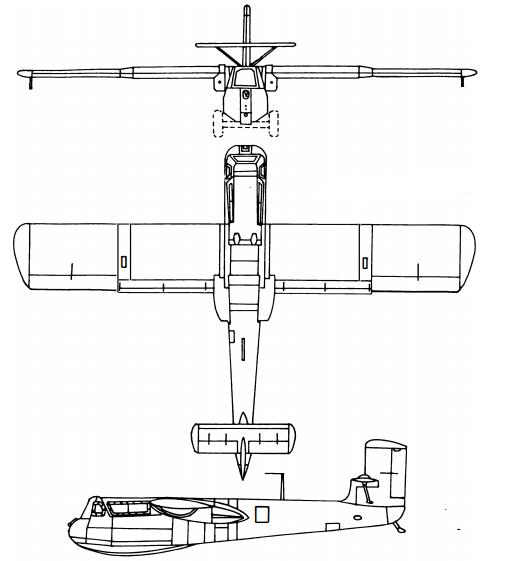| Type |
Single seat parasite figher |
| Dimensions |
Length 5,7 m , height 1,63 m , span 7,9 m , wing area 8,7 m2 , |
| Weights |
Empty 838 kg, loaded 952 kg , max. take off weight |
| Performance |
Max.. speed 900 km/h, landing speed125 km/h |
| Armament |
2 fixed, forward-firing 30 mm Rheinmetall-Borsig MK 108 cannon with 35 rpg |
| Type |
Werk.Nr |
Registration |
History |
| V1 |
|
|
In the last days of May 1944 the first experimental glider BV.40-V1 was lifted into the air for Bf.110 |
| V2 |
|
|
|
| V3 |
|
|
BV.40-V3 was destroyed during static tests |
| V4 |
|
|
V4 was seriously damaged during experimental flights |
| V5 |
|
|
|
| V6 |
|
|
|
| V7-V20 |
|
|
Lost during one of many Allied bombing raids on Germany. |
The Blohm & Voss BV 40 was a German glider fighter designed to attack Allied bomber formations during the time of the bombing raids over Nazi Germany.
The BV 40 was the smallest glider that could accommodate an armoured cockpit and two cannon with limited ammunition. By eliminating the engine and lying the pilot in a prone position (i.e. on his front), the cross-sectional area of the fuselage was much reduced, making the BV 40 harder for bomber gunners to hit.
The plane was designed to use non-strategic materials and to be built in as short a time as possible by non-skilled workers. The fuselage was constructed almost entirely of wood. It was of conventional layout, the glider had a high-mounted, straight untapered wing with a similarly-shaped tailplane mounted on the fin just above the fuselage. The pilot lay prone in an armoured steel cockpit in the nose of the aircraft. The front steel plate was 20 millimetres thick, and was fitted with a windscreen of 120-millimetre thick, armoured glass that gave the aircraft a blunt-nosed appearance.
Two 30 mm MK 108 cannon were mounted in the wing roots.
There was no conventional undercarriage. A twin-wheeled dolly was used for take-off and dropped once the glider was airborne. A skid under the nose was lowered for landing.
The BV 40 interceptor glider was conceived by Dr Richard Vogt, chief designer and technical director of Blohm & Voss, as a low-cost emergency solution to the problem of the Allied bomber formations which were devastating Germany in the latter half of World War II. It was to be towed by a Messerschmitt Bf 109 to operational altitude and released above the Allied bombers' combat box. Once released, it would dive down at a sharp angle towards the enemy bomber fleet. During its short attack time, the BV 40 would fire its weapons, then glide back to earth. Several prototypes were completed and flown, towed behind a Messerschmitt Bf 110. The first flight took place in May 1944. It was found the craft could reach 470 km/h and it was thought to have the potential to go far faster.Various changes to the requirement and to the design were discussed, before the project was cancelled later in the year. In all, seven aircraft were completed and five of them flown. Owing to the potential dangers for the pilot inherent in the operation of this precarious aircraft, the BV 40 is sometimes listed as a suicide weapon, but it was not intended as such.
From the very first days of the existence of the Blom und Voss aircraft manufacturing department, its chief designer and technical director, Richard Vogt, showed a very definite penchant for extraordinary projects and rather radical solutions. As a result, even the most "conservative" of his projects were rejected by the Technical Department as a manifestation of design fantasy. Given the RLM's strong commitment to traditional solutions, it is somewhat surprising that Vogt's most original proposal - a small, heavily armored glider to attack enemy bombers - received official support. In January 1943 formations of American bombers B-17 "Fortress" for the first time invaded deep into Germany. They flew in close formation, known as a "battle box", to provide maximum mutual fire support. The very first combat clashes showed that the forehead of the Fw.190 with its radial engine - 1.5 sq.m is a good target for the B-17 shooters, capable of hitting it from a distance of more than 1000 m. It was clear that it was possible to reduce the "forehead" of the fighter really only excluding the engine. Having drawn this conclusion, Vogt proposed to the Technical Department the idea of a non-powered interceptor - a fighter glider made of non-deficient materials and raised to combat height by an ordinary fighter. It was assumed that the glider would be able to approach, almost invisible to the bomber gunners, to the effective fire distance of its 30-mm guns. It was obvious from all points of view that balanced and non-standard solutions would be required to counter the American bombers, and Vogt put forward his invention, which, for some incomprehensible reasons, received the designation VV.40. A distinctive feature of the VV.40 was the use of non-deficient materials, which were processed by carpenters, joiners, welders and locksmiths who did not have the experience of aircraft manufacturers. The cockpit, in which the pilot was reclining on a pillow, was welded from steel sheets. The front sheet is 20mm thick, the side and drop top panel is 3mm, the bottom is 5mm. The frontal bulletproof glass was 120 mm thick, and two sliding armored panels covered the side windows. The pilot's legs were protected by 8mm armor. The central section of the fuselage, made of riveted metal, was bolted together with a wooden tail. The wing and plumage are also of wooden construction. Wing with one box-shaped plywood main spar and two auxiliary ones behind and in front of the main one. It was sheathed with 4mm plywood and attached to the fuselage with four bolts. A drop two-wheeled cart was used for takeoff, and a semi-retractable ski for landing. Landing accuracy was provided by flaps lowered by 80 °. Vogt originally planned to limit armament to a single MK-108 gun with 70 rounds. He believed that if, after the first attack, the altitude allowed for a second approach, then the Herat Schlinge (loop projectile) should have been used - a cable lowered from a glider with a small explosive charge. However, it was agreed that the glider had to carry out a frontal attack at a speed of 400 km / h, approaching the target at 800 km / h, so that the pilot could hardly manage to make more than one burst, which should have been as powerful as possible. As a result, it was decided to install two guns with the same ammunition, and remove the "loop projectile". For takeoff VV. 40 was mounted on a two-wheeled cart and attached with a 30-meter cable to the Bf.109g or Fw.190. The glider pilot dropped the undercarriage just after takeoff. During a normal landing, the ski was released, and the flaps were deflected by 50 °. The maximum deflection of 80° was allowed only in an emergency. In the last days of May 1944 the first experimental glider BV.40-V1 was lifted into the air b Bf.110. The pilot reported after the flight that the controllability of the glider was good, including in the turbulent flow behind the tug. The second flight was carried out on June 2, 1944 in Wenzendorf. The base of the take-off cart for greater stability during the takeoff run has been increased, and the tire pressure has been reduced. The pilot uncoupled from the twplane at an altitude of 800 m and a speed of 240 km/h. Then the speed was reduced to 150 km / h. At the same time, the controllability remained normal, but at a speed of 140 km / h the glider suddenly “fell” down and crashed onto the border of the airfield, plowing 25 meters. The second experienced BV.40-V2 was already ready. The first two flights on it were performed on June 5. In the next two flights three days later, a speed of 330 km / h was reached when uncoupling at an altitude of 2200 m. The BV.40-V3 was destroyed during static tests, and the V4 was seriously damaged during experimental flights. On tests it was replaced by V5. July 27, 1944 BV.40-V6 was transferred from Stad to Wenzendorf in tow behind Bf.110. It was the first long distance flight. The pilot after the flight reported that the journey was extremely tiring. Lying prone, resting his chin turned out to be very difficult. By this time, it was established that the controllability of the airframe is sufficient. 19 vehicles were ordered with a completion date of March 1945. At the same time, an order for an installation batch of 200 BV.40a followed, but the Technical Department had already begun planning changes in armament and equipment. It was planned to install a rocket or pulse engine and even change the purpose of the airframe. Flieger staff engineer Tilenius suggested equipping the Bv 40 with small bombs with remote fuses to drop the bombers into formation. The maximum load was planned from four BT-700 bombs under the wing. It was assumed that a pair of Bv.40 could be hung under the He.177A-5 or B-5. It was planned to put an automatic control system, a rocket engine, or even use the airframe as a towed fuel tank. By the middle of July 1944. the main test program was completed. At an altitude of 2000 m, a speed of 470 km / h was reached. It was believed that in a dive you can reach 900 km/h. True, there were doubts about the possible flutter of the ailerons. To eliminate such a danger, they expected to reduce the area of the ailerons by 40%. It was planned to conduct research on this issue in the autumn of 1944, when the program was terminated. The V.40-V7 was completed in August. The readiness of V8 and V9 was planned for September and October, respectively. The remaining 10 airframes were to be manufactured at a rate of two per month.















